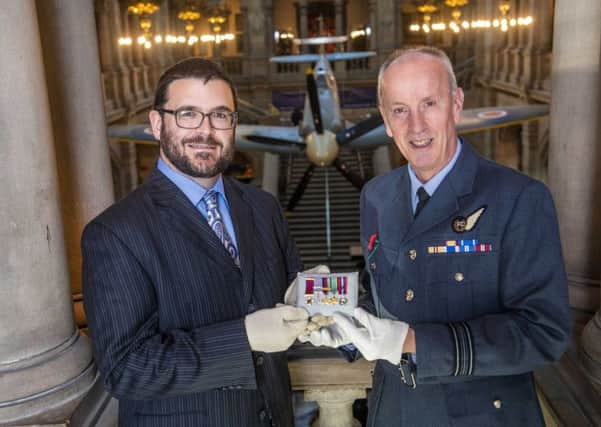Exploits of Glaswegian ‘ACE’ WW2 pilot explored in new display at Kelvingrove Museum


The exploits of distinguished pilot, Squadron Leader Archibald ‘Archie’ McKellar CSO DFC & Bar, who shot down the first German aircraft on British soil on 28 October 1939, helps convey the human side of conflict.
Located within the wider Conflict and Consequences gallery, which explores the true cost of war, the display features a number of items on loan from the 602 Squadron Museum’s collection.
Advertisement
Hide AdAdvertisement
Hide AdThese include a wing panel from the Heinkel EH-111 Bomber shot down by McKellar, important as it allowed others to study the plane and learn the secrets of German aircraft design. Pieces were often taken as souvenirs, two of which survive to this day. Also on show are letters he wrote and received, photographs and a portrait, together with a uniform representing the one Archie would have worn in 1940, crucial in protecting him from the freezing temperatures experienced at higher altitudes.


Roddy MacGregor, Honorary Secretary of 602 (City of Glasgow) Squadron Museum Association was among the first to see the new display at Kelvingrove Museum. He showed visitors some mini medals Archie McKellar had won while in action during WWII. He was joined by Sqn Ldr Archie McCallum, current commander of the 602 (City of Glasgow) Squadron.
He said: “We’ve relished the opportunity to work with the team at Glasgow Museums to create this new display on the 602 (City of Glasgow) Squadron’s actions at the start of World War II. We very much hope it will add to the important conversation about the human side of conflict today.”
Chair of Glasgow Life, Councillor David McDonald, said: “More than 1 million people visit Kelvingrove every year and they return time and again because we work hard to refresh the stories we share in our 22 themed galleries.
Advertisement
Hide AdAdvertisement
Hide Ad“Our Conflict and Consequences gallery explores themes that are sadly all too real for many across the world today, therefore it is important we continue to raise awareness of the enduring human cost of conflict. This idea is imbued in Archie McKellar’s story. It is evident to all he was an incredibly brave man and we are all grateful to him for making the ultimate sacrifice. We are also grateful to the 602 City of Glasgow Squadron Museum Association for helping to create this new display”.


Born in 1911 Archie McKellar, who attended Shawlands Academy, wanted to join the army, but his parents thought it too dangerous. Before the war he was a part-time pilot, working as an apprentice plasterer for his family business. He joined the Auxiliary Air Force in 1936 and was commissioned as a Pilot Officer in 602 (City of Glasgow) Squadron.
Following the outbreak of war in September 1939, the Spitfires of 602 Squadron were posted to RAF Drem in East Lothian. On 28 October he shot down a Heinkel 111 Bomber over Humbie, near Edinburgh, claiming the first German aircraft shot down on to British soil in WW2. In 1940 he was promoted to Flight Lieutenant and went on to become one of the ‘Few’, the men credited by Prime Minister Winston Churchill as winning the Battle of Britain and seeing off invasion.
Archie became a successful and decorated fighter pilot. He was awarded the Distinguished Flying Cross and Bar and the Distinguished Service Order for shooting down 21 enemy aircraft, including five Messerschmitt Bf 109 fighters in a single day, earning him the illustrious honour of ‘fighter ace’.
Advertisement
Hide AdAdvertisement
Hide AdUltimately after only 14 months, like so many other young men of his generation, war cost him his life. He was shot down and killed in action over Kent on 1 November 1940, aged just 29. Glasgow’s Lord Provost Sir Patrick Dollan conveyed his sadness and thanks to the McKellar family on the death of their son – calling him a ‘Number One Man’. This letter forms part of the display.
At the time Archie McKellar flew for 602 (City of Glasgow) Squadron they were equipped with the latest fighter aircraft, the Supermarine. One of Kelvingrove Museum’s most popular exhibits is a slightly later version built in 1944, the Spitfire LA198, which features a Rolls Royce Griffon 61 engine and a five blade propeller.
It flew with the Squadron between 1947 and 1949. It was restored in a joint project between Glasgow Museums and the National Museums of Scotland and has been on display, hanging above the popular Life Gallery in the museum’s West Court, since the museum re-opened after significant refurbishment in July 2006.
602 (City of Glasgow) Squadron is a Royal Auxiliary Air Force squadron. It was originally formed in 1925 as a light bomber squadron, before its role changed in 1938 to army co-operation and in 1939 to that of a fighter squadron. During WWII the squadron flew Spitfires and took part in the Battle of Britain. After the war, the squadron was reinstated as a fighter squadron within the Royal Auxiliary Air Force, until all these units disbanded in March 1957. Reformed on 1 July 2006, the squadron presently assumes the ISTAR mission support role formerly held by the Mission Support Element (MSE) of 603 (City of Edinburgh) Squadron. The role provides flight operations and intelligence support to the RAF at home and overseas.
The Conflict and Consequences gallery is located on the first floor of Kelvingrove Art Gallery and Museum, for more information visit www.glasgowmuseums.com